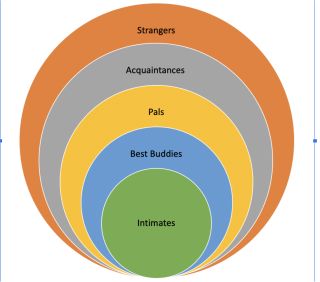ADHD- Adult ADHD and Friendship. How to reduce social anxiety and create rewarding peer relationships. Reviewed by Ekua Hagan

KEY POINTS-
- Social anxiety and rejection sensitivity dysphoria make it harder for those with ADHD to maintain friendships.
- Practicing communication skills assists people in making progress with social interactions over time.
- Healthy friendships are a give and take which enrich one's life in countless ways.

Friendship is deeply important to our well-being. It provides mutual acceptance, warmth, and support between people. It’s a refuge and a place where you can safely be yourself and connect with others. Friends share interests, personal stories, and humor and enjoy spending time together.
Recently, the Surgeon General of the United States released a report that found that loneliness and smoking are similarly dangerous for our health. However, making and keeping friends doesn’t always come naturally for adults with ADHD. Challenges like social anxiety and rejection sensitivity dysphoria (RSD), which are common among adults with ADHD, may make it difficult to form and maintain friendships despite feeling lonely and wanting comradeship.
Bringing awareness to these obstacles is the first step in relieving some of the stress around interpersonal relationships. Greta, age 25, says: “I feel that a lot of times I genuinely do want to socialize and get to know people. But trauma and fear of rejection disable me from doing it. It’s hard to fight my brain to meet this goal.”
Previous experiences of bullying, exclusion, or harassment can prevent folks from reaching out, despite feeling lonely. Practicing some practical communication skills assists individuals in making progress over time, step by step. Let’s take a closer look at some key strategies which will make it easier for adults with ADHD to enjoy close connections and strong friendships.
Fear and social anxiety
Fear is one of the most commonly reported obstacles to making friends for those with ADHD. Core beliefs related to a feeling deficient in some way, so common to living with ADHD, can feel overpowering and debilitating. This negative voice in your head may say any of these phrases: "I will embarrass myself; I will make a bad first impression; People won’t like me right away. I have to be perfect to be liked; I'm too forgetful to be a reliable friend."
You may know cognitively that you have nothing to fear and that these statements are not true, but your negative brain goes into overdrive and overwhelms the positive parts. Some amount of worry in social situations is natural and expected. But if left unchecked, this can lead to social anxiety, which will require more care and often therapy to manage.
Social anxiety is a fear that people will scrutinize you in either familiar or unfamiliar social situations, and this negative judgment will have harmful effects on you. These worries about humiliation and rejection are persistent and restrict your activities, interests, and relationships. Social anxiety interferes with making and keeping friends. It’s a negative response to a trigger such as social (conversation), performance (carrying out a function in front of another person), or being observed that is beyond the actual threat of the situation. It can occur before (over-thinking), during (distractedness and visible nervousness), or after (beating yourself up and obsessing about what you did or didn’t do) a situation. The worst part of social anxiety is that you know what you are doing doesn’t make any sense, but you can’t stop.
Rejection sensitivity dysphoria
Rejection sensitivity dysphoria (RSD) is a common co-existing condition with ADHD and social anxiety but not a formal diagnostic category. Rejection-sensitive dysphoria refers to intense feelings related to the belief that you’ve let other people down, embarrassed yourself, failed at something, or made a serious, unfixable mistake and, as a result, people pull back their support, love, or respect.
RSD causes extreme emotional pain that plagues both children and adults-—even when no actual rejection has taken place. When you are so concerned about humiliation or doing something wrong, it's really tough to relax and enjoy connecting with somebody or sharing yourself in a genuine fashion.
What you need to make friends

When social interactions and making friendships are challenging, you need strategies. There’s a saying I really like: “Be a friend to have a friend.” When you express caring toward someone and extend a hand in friendship, you will put yourself in a better position for friendships to blossom. Sure, you may need to “make the first move,” introduce yourself, and get the ball rolling, and this can be uncomfortable at first. With enough practice, you’ll get the hang of it, and I assure you, it will get easier.
Making friends as an adult typically depends on these four factors:
- Resilience is key to making friends; being able to shift and be flexible.
- Geography makes a difference. It's easier access to people and spend time with them when they live near you.
- Seeing people repeatedly throughout a range of settings builds trust and enjoyment of each other’s company. Build up information about a person’s behavior, likes, and dislikes.
- Having similar interests and being in the same spaces. Some examples are work, school gym, hobbies, and religious organizations.

Types of friendships
It’s also important to remember that friendships come in different varieties in what I see as a layered circle. Of course, it’s natural to have movement between these layers there’s as we become closer with some folks and less friendly with others.
Intimates are usually your family (genetic or chosen), your loved ones, your partners, and perhaps one or two long-time, special friends. There is complete familiarity with each other.
Best buddies tend to be your closest friend(s): a few people who fully accept you as you are and whom you fully accept too. There’s trust, honesty, loyalty, and deep caring in these relationships. These are your go-to people in any situation.
Pals are friends at the next level: You spend time with them, you like each other, you share interests and activities, and you know many things about each other but you don’t expect them to show up for you in the same way as best buddies.
Acquaintances are folks you see around: You may know them a bit; you say "Hello" when you pass them. These are people you see at work or at the gym. You may even get a cup of coffee with them to get to know them better because they seem interesting. Acquaintances can be potential pals. You’re friendly and you know some things about each other, but you rarely hang out.
Strangers are people you don’t know now, but, who knows? You may meet them someday. These are people who may say "Hello" as they pass you on the street or ask about the weather while you’re both in line at the grocery store. Feel free to respond briefly or engage in chit-chat if you’re interested.
How to build connections
The next time that you’re in a social environment, see if you can apply some of these strategies to build connections with peers:
- Ask relevant questions and assess what’s happening by looking at people’s faces.
- Be aware of physical proximity and volume. Place yourself appropriately near others, observe their volume, and do the same.
- Join in a conversation after observing and listening to what’s going on. Participate, using reflective statements that show you’re listening. Show genuine curiosity about others’ experiences and avoid judgments.
- Lay off self-criticism. Turn down the volume on the internal negative voice that guesses what other people are saying about you because it’s often wrong; stay present and engaged with what’s happening now.
- Practice makes progress. This is particularly true with chit-chat. You don’t have to like this, but you may need this skill at times. Practice in low-value/intensity situations: at the grocery store, at the dry cleaners, or at the library. “How are you today?” “Nice weather isn’t it?” ”Thanks for helping me.” Set a goal to engage in at least one brief exchange with someone each time you run an errand, go to the gym, or at work.
Enjoy connecting with others and sharing what’s special and fun about you while listening and welcoming what’s interesting and compelling about others. Healthy friendships are a give and take which will enrich your life in countless ways.
- Questions and Answers
- Opinion
- Story/Motivational/Inspiring
- Technology
- Art
- Causes
- Crafts
- Dance
- Drinks
- Film/Movie
- Fitness
- Food
- Games
- Gardening
- Health
- Home
- Literature
- Music
- Networking
- Other
- Party
- Religion
- Shopping
- Sports
- Theater
- Wellness
- News
- Culture
- War machines and policy

